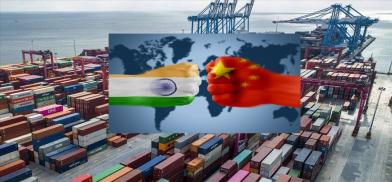Can India shake off the dragon's growing tentacles in South Asia?
The dragon’s shadow has lengthened over the South Asian region as it has rapidly developed port and transport infrastructure, some of it as part of its Belt and Road Initiative, writes N Chandra Mohan for South Asia Monitor

China is doubling down on a range of its territorial disputes with South Asian neighbours like India to the South China Sea. During the last three months, there has been a tense face-off on its border with India in the western Himalayan region of Ladakh. High-level military and diplomatic parleys have resulted in gradual de-escalation of hostilities. But there is unlikely to be any return to status quo ante as the consensus that guided bilateral relations for several decades has broken down. India, for its part, has upped the ante by regulating Chinese investments and reducing its dependence on imports and technology from the mainland, among other measures.
India’s far bigger challenge is to defend turf against the dragon’s growing influence in the neighbourhood. India’s Prime Minister Narendra Modi rightly believes that having a good neighbourhood is a universal aspiration and signaled his foreign policy priorities when he invited leaders of the South Asian Association for Regional Cooperation (SAARC) for his swearing-in ceremony in May 2014. Due to problems with Pakistan, however, this grouping receded in importance. India is no doubt the dominant power in South Asia and Indian Ocean and it cannot but be concerned that China has developed a much deeper engagement on trade and investment.
India’s interests from Aden to the Straits of Malacca too are imperiled by the rise of China as a maritime power. Due to their quest for energy security, the Indian Ocean is where the rivalry between India and China is most intense. The Chinese leadership since the presidency of Hu Jintao has fretted over the so-called Malacca dilemma. Far from recognizing this ocean as India’s zone of influence, China’s strategy has entailed building up naval bases in Djibouti in Somalia, Gwadar in Pakistan, Hambantota in Sri Lanka, Chittagong in Bangladesh and Sittwe in Myanmar to ensure that the sea lanes are safe for its oil supplies from West Asian countries.
India’s heft in South Asia has certainly diminished as regional integration has been allowed to drift. Trade within the region is one of the lowest in the world, a consequence partly of the fact that Pakistan has denied most-favoured-nation (MFN) status to India’s goods. India, too, withdrew MFN status to Pakistan last year. MFN status ensures non-discriminatory trade between partner countries. An important reason why South Asian integration remains a distant dream is that most member countries also resent India’s dominance. Their resentment has only deepened as every SAARC member has registered huge trade deficits with India.
South Asia thus is a diminishing priority focus for India, accounting for only 1.7% to 3.8% of its global trade. In sharp contrast, China has notched up large trade volumes, rising more than six-fold from USD 9.2 billion in 2005 to USD 60 billion in 2018, while India’s increased less spectacularly from USD 7.4 billion to USD 31 billion over this period, according to a policy brief of Brookings India, “India’s limited trade connectivity with South Asia”. That China has also become Bangladesh’s largest trading partner is a painful reminder to India of its failure to deepen regional integration. Bangladesh accounts for one-third of China’s trade with South Asia.
The dragon’s shadow has lengthened over the South Asian region as it has rapidly developed port and transport infrastructure, some of it as part of its Belt and Road Initiative. It has eased the debt burden of Maldives and provided aid to Sri Lanka and Nepal to develop its northern border districts. A rail corridor has been recently activated that allows access for land-locked Nepal’s goods to Chinese seaports in Tianjin and Shenzhen. The closer embrace with China has certainly emboldened the government of this Himalayan country under Prime Minister K P Oli to include parts of Indian territory like Kalapani, Lipulekh and Limpiyadhura in its new map.
To counter-balance China, India must contribute to greater flows of trade within the region through unilateral trade liberalization. India must also step up its investments in South Asia. The scale of this challenge is immense as China's investments have cumulated to USD 116.6 billion according to the American Enterprise Institute’s China global investment tracker. Most of these investments are in Pakistan (USD 56.3 billion), Bangladesh (USD 26.9 billion) and Sri Lanka (USD 13.8 billion), the bulk of it to build power, ports, roads, bridges and airports.
A hopeful sign is that the exigencies of dealing with the viral pandemic provided PM Modi an opening to reach out again to SAARC. His video conference and the follow-up with medical supplies to neighbours exemplify how soft power can further opportunities to shore up India’s preeminence in the region. South Asia has limited resources. Its human security indicators per person are woefully inadequate. The region is dependent on public health institutions, which is woefully short of requirement and it has the bulk of the world’s poor.
(The writer is an economic and business commentator based in New Delhi. The views expressed are personal)










Post a Comment